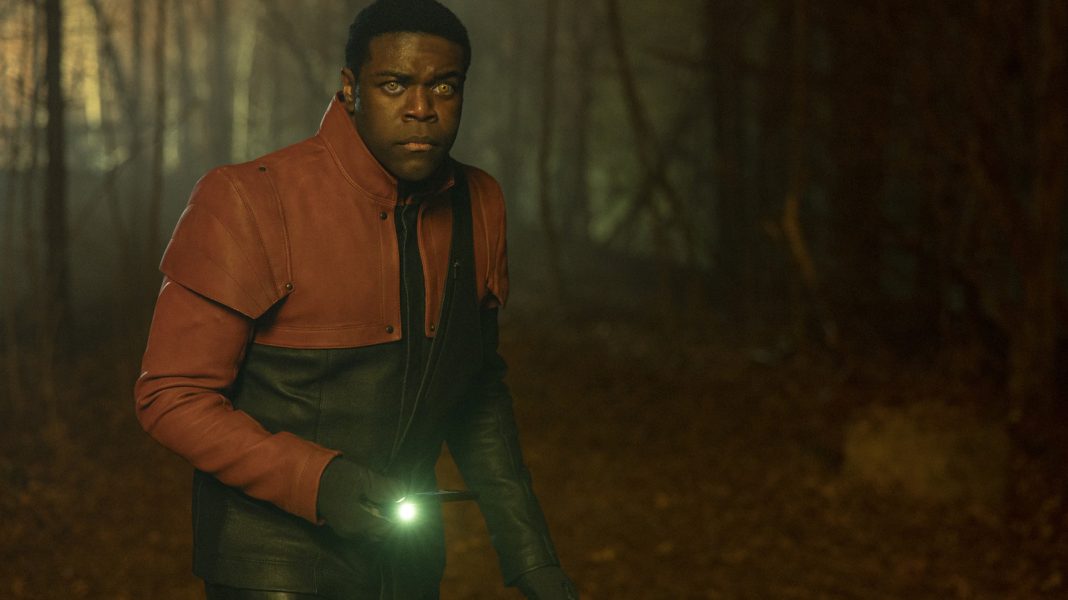Max Nelson, Women in Trouble — Sidecar – New Left Review

The first film David Lynch ever saw, when he was six years old, was a 1952 melodrama by the director Henry King called Wait Till the Sun Shines, Nellie. Shot in bright orange candlelight and deep nocturnal blues, it offers a prehistory for the kind of small American town that Lynch’s own films would later scrutinize. In the film, a barber sets up shop in the mid-1890s in a tiny Illinois settlement which we follow through half a century of growth and modernization. Disaster follows disaster: when his wife learns that he told her a series of lies to make her stay put in a dead-end town, she flees to Chicago only to die in a train crash; their son comes back from World War I so accustomed to killing that he joins the mob and meets a violent end of his own. The critic Gina Telaroli found it fitting that Lynch’s first trip to the cinema was for a film about these sorts of buried domestic sins. The movie itself seems to sense something ominous thrumming under its surface. ‘I wish that you’ll never be hurt, and I wish that you’ll never hurt anybody else’, the widowed barber tells his children on New Year’s Eve, 1900. ‘You’re going into a wonderful time – the twentieth century.’Lynch’s films owe a debt to melodrama, with their emotional extravagance, their extreme juxtapositions of innocence and evil, and above all their abused and exalted heroines. But Lynch, who died last week at seventy-eight, preferred to put much of his work in a different genre. ‘Basically it’s a mystery’, he told Chris Rodley in the book-length interview collection Lynch on Lynch (1997) about his Los Angeles neo-noir Lost Highway (1997). Twin Peaks – the TV series he oversaw with Mark Frost between 1990 and 1991, spun into a harrowing feature-length prequel in 1992, and concluded with a death-haunted third season in 2017 – was ultimately, he said, a ‘murder mystery’. Blue Velvet (1986), his first allegory of suburban brutality, was ‘a dream of strange desires wrapped inside a mystery story’.What kind of mysteries are these? Often they hinge on the discovery of a body, or part of one: a severed ear in Blue Velvet, an isolated woman found in her apartment in Mulholland Drive (2001), a John Doe’s torso with a Jane Doe’s head in Twin Peaks: The Return (2017), the corpse of Laura Palmer floating back to Twin Peaks ‘wrapped in plastic’. They have a lurid interest in death and gore, often cut with droll understatement. (‘Yes, that’s a human ear, all right.’) They bombard the viewer with clues, cyphers and gnomic sayings. A typical example comes, in Mulholland Drive, from an eyebrow-less man identified only as ‘the cowboy’, who gives a baffled Hollywood director a prophecy: ‘You will see me one more time if you do good. You will see me two more times if you do bad.’ We see him two more times.These are movies teeming with large casts of possible suspects, witnesses, hangers-on, and what the critic Jenny Turner, writing in another context, calls ‘freelance chthonic forces’: crazed Cassandra figures who show up at doors announcing future catastrophe, animals like the beetles and robins that do allegorical battle in Blue Velvet, benevolent spirit guides like the ‘log lady’ of Twin Peaks, and malevolent roaming presences like the young boy wearing a long-nosed plaster mask in Twin Peaks: Fire Walk With Me (1992) or the ‘phantom’ who makes ghastly visitations throughout Inland Empire (2006). The camera likes to float between these points of view. Sometimes it hovers above the human figures like a watchful demiurge, sometimes it occupies their own unstable perspective with lurching handheld footwork, sometimes it hugs the ground like a child, or a bug. A year after the release of Blue Velvet, Cindy Sherman enthused to Gary Indiana about Lynch’s ‘horrible, real low-down camera angles, practically on the floor, looking around at these close-ups of decay’.There is a temptation to try to pull the clues together, to find the master code that makes it all cohere. It has become a cliché, in writing about Lynch, to warn against that temptation: to stress that the riddle can never be solved, that the films only disclose their uncanny, ineffable logic when you stop trying to decode them. And yet there is strikingly little ambiguity at the heart of Lynchworld. The films are so unnerving precisely not because they leave themselves open to a proliferation of interpretations but because they wrap clues, cyphers, and allegories around a hard, unambiguous core of cruelty and pain.There is plenty of violence to go around: minor characters in Lynch’s movies often meet awful ends casually, as if killing and sadism were just in the air. But more than half of his ten features centre – with a kind of stricken horror – on violence against women. A father abuses and kills his daughter; a jealous husband kills his wife; a woman driven to despair by grotesque men hires a hitman to kill her lover. Characters such as Sheryl Lee’s Laura Palmer, Isabella Rossellini’s Dorothy Vallens and Laura Dern’s Nikki Grace command their respective films both by the ferocity of their resistance and the intensity of their suffering, which the movies repeatedly depict as the base of a pyramid of exploitation. Dorothy’s rapist runs corruption rackets in scenic Lumberton that implicate the local police; Laura’s father does legal work for Twin Peaks’s local tycoon.The mystery, then, is where all this violence comes from. ‘Why’, the young naif Jeffrey (Kyle MacLachlan) asks in Blue Velvet, ‘is there so much trouble in this world?’ Three decades later, in a particularly gruesome episode of Twin Peaks: The Return, Janey-E (Naomi Watts) echoes him: ‘What kind of world are we living in where people can behave like this?’ If these sound like childish questions, it might be because, for Lynch, they were. When Rodley asked if he had been ‘frightened by many things as a child’, he clarified that he was ‘really troubled. I would think, “This is not the way it is supposed to be”, and it would trouble me.’ It was as if the trouble never quite left him, as if all the gothic, surreal, comic and fantastic embellishments were ways of metabolizing a violence too blunt and literal to process any other way.Lynch remembered his childhood with a mixture of fondness and dread. Born in Montana in 1946 to a mother from Brooklyn and a father who worked for the agriculture department of the US government, he moved often, first within the Northwest (Sandpoint, Spokane, Boise) and then South (Durham, Alexandria). He was a child of the Fifties, ‘a fantastic decade in a lot of ways’, he told Rodley. Its music set the tone for his films: a ‘suave’ gangster wearing powder and eyeliner lip-synchs to ‘In Dreams’ in Blue Velvet; Nic Cage serenades Laura Dern in a crocodile-skin jacket to ‘Love Me’ in Wild at Heart (1990); a girl group croons ‘Sixteen Reasons’ on a soundstage in Mulholland Drive. But what he singled out first were the cars. ‘Designers were really out there with fins and chrome and really amazing stuff. Horse-power was a big deal . . . Old cars would weather a crash but the people inside would just be like, you know, mutilated!’His comfortable life, he saw from time to time, was propped up by disquieting facts. Visiting his mother’s family in Brooklyn, he found that his grandfather ‘owned an apartment building . . . with no kitchens’, requiring at least one tenant to cook an egg using a clothes iron. ‘I learned that just beneath the surface there’s another world’, he explained to Rodley. ‘There is goodness in blue skies and flowers, but another force – a wild pain and decay – also accompanies everything.’Lynch was a painter before he was a filmmaker, studying art in Washington D.C., briefly touring Europe with his friend the future production designer Jack Fisk, and working a series of odd jobs (frame-shop employee, janitor, doorman). In 1965 he and Fisk both enrolled at the Pennsylvania Academy of Fine Arts, where Lynch met his first wife, welcomed his first child, and started making short films.He often said that he took inspiration for his debut feature, Eraserhead (1977), from living in an industrial, economically depressed part of the city: ‘I always say it’s my Philadelphia Story’. But large swathes of the black-and-white feature take place in a single claustrophobic room with spare lighting and bare walls. There we watch Henry (Jack Nance) struggle to tend to his skinless, monstrous infant, dream about bodily mutilation, and listen for serenades from the ‘woman in the radiator’, who reminds him that ‘in heaven everything is fine’. Having originated as Lynch’s thesis film at the American Film Institute’s newly opened graduate program, Eraserhead made his reputation on the emerging midnight-movie circuit just as his New Hollywood peers were going mainstream. (For all its dream logic, it too proceeds from a quite literal, unambiguous premise. Some fifteen years ago I clerked at a video store with an enormous Eraserhead poster on the stairs; one day, a seven-or-eight-year-old girl asked her dad what the movie was about. ‘It’s about the fear of fatherhood’, he said instantly.)By the time he made Eraserhead, Lynch was already living in Los Angeles, where he would stay for the rest of his life. His first feature was also his farewell to the Northeast; the geography of subsequent films would cut a swath from North Carolina timber country (Blue Velvet) through the Texas desert (Wild at Heart), the agricultural heartlands of Iowa and Wisconsin (his 1999 Disney road movie The Straight Story), the lumber towns of the Pacific Northwest (Twin Peaks), and the exurbs of Las Vegas (Twin Peaks: The Return). The country’s centre of gravity for Lynch was not New York but LA, the setting of his three most ambitious features, which he filmed with casual, confident intimacy. When David Foster Wallace visited the set of Lost Highway, the first entry in Lynch’s informal LA trilogy, he asked a range of crew members what they thought of the movie. ‘Read City of Quartz’, one said. ‘That’s what this film’s about right there in a nutshell.’After a warmly received second feature in 1980 (The Elephant Man) and an expensive flop four years later (Dune), Lynch’s exasperated producer, Dino de Laurentiis, gave him a pittance to make Blue Velvet just as he pleased. It set the template for the rest of his career: MacLachlan’s curious college boy gets entangled both with an innocent dreamer (Laura Dern) and with a nightclub singer imprisoned by the sadistic mobster who kidnapped her husband and son. Lynch might have never made a more straight-ahead melodrama. As the traumatized Dorothy Vallens, Rossellini could be starring in a pre-code tragedy like Frisco Jenny (1932) or Torch Singer (1933), channelling the character’s agony into a kind of fierce authority.Aside from a handful of disquieting dream sequences, Blue Velvet stabilizes its vicious content with a relatively conventional form. Twin Peaks, which premiered four years later on ABC, instead casts its story of abuse in what would come to seem Lynch’s distinctively surrealist mould: a wide cast of petty monsters and comic weirdos, an equally varied lineup of supernatural forces, a range of indelibly otherworldly settings (most famously the chevron-floored, curtained ‘red room’), a certain nonlinear freeness with time and space. Here the tragic heroine was a structuring absence, murdered before the show began.Only in Twin Peaks: Fire Walk with Me did Lynch finally try to imagine her. It met with a staunchly negative response. ‘Perhaps’, Rodley speculated to Lynch, ‘the problem was that by concentrating on Laura Palmer’s last seven days, the movie reminded people that at the centre of Twin Peaks was a story of incest and filicide’. (‘Maybe so’, Lynch replied.) Audiences might also have bristled at the jagged shape of the movie itself: Sheryl Lee’s extraordinarily visceral breakdowns keep triggering hectic superimpositions and cuts to unexplained tableaux. Fire Walk with Me never seems quite like a literal depiction of Laura’s dissociative trauma; it is more as though the very act of showing her suffering puts enough pressure on the film to make it fray at the seams.In Lost Highway and Mulholland Drive the pressure gets so strong it splits the films in half. Both movies play out in two sections, each starring the same actors in different roles, or variations on a theme. In each case we pass from one part – one reality – to the other when the camera zooms into a field of darkness and a pallid, spectral figure beckons us to the other side. Both movies, too, juxtapose a sordid story of LA murder with a dreamier, more romantic narrative. Reality and fantasy, then – but even the fantasy sections seem nagged by troubling thoughts. Throughout Mulholland Drive’s first two hours, Naomi Watts’s cheerful, guileless aspiring actress – newly arrived in LA from Deep River, Ontario – keeps catching glimpses, from behind the veil, of the wrecked, nihilistic woman she’ll become, or has already become.The more porous and formally splintered they got, the longer the films grew and the more digressions, B-plots, and bit characters they accommodated. The violence has broken its banks and seeped into all sorts of other unrelated lives. (In the film’s first half-hour, for instance, Mulholland Drive makes room for a queasily prolonged assassination scene and a nervous man’s encounter with a matted, scabrous figure behind a diner called Winkie’s.) It also, quite literally, corrupts the wider social world: Lost Highway and Mulholland Drive both imagine LA as a city beholden to inscrutable mobsters who beat up people for tailgating or spit out their espresso if it fails to meet their standards.Inland Empire, Lynch’s last feature, is not just halved but quartered, or eighthed. Dern’s character, another actress, takes a role in a cursed film production and starts feeling the boundaries of her identity erode. Over the course of the movie – shot on low-fi digital video, often in extreme close-up – a widening range of women start speaking through her: young sex workers, wives oppressed by their husbands, a woman in thrall to a carnival hypnotist, a woman recounting her lifelong struggle against violent men. Dern, who plays at least three of the women herself, has to encompass the whole chorus of pain, or perhaps record it. (The film starts with a shot of a stylus dragging over an LP.) Lynch gave it a droll tagline: ‘A woman in trouble.’It was a crisp summary of his most abiding fixation. Of all the childhood memories Lynch recounted over the years, one from his time in Boise, Idaho recurs as something like a primal scene. He and his brother ‘were down at the end of this street at night’, he remembered in his memoir Room to Dream (2018), cowritten with Kristine McKenna:and out of the darkness – it was so incredible – came this nude woman with white skin. Maybe it was something about the light and the way she came out of the darkness, but it seemed to me that her skin was the colour of milk, and she had a bloodied mouth. She couldn’t walk very well and she was in bad shape, and she was completely naked. I’d never seen that, and she was coming toward us but not really seeing us. My brother started to cry and she sat down on the curb. I wanted to help her but I was young and didn’t know what to do. I might’ve asked, Are you okay? What’s wrong? But she didn’t say anything. She was scared and beat up, but even though she was traumatized, she was beautiful.That childhood encounter both found its way into the films directly – Lynch restaged it in Blue Velvet and in the first episode of Twin Peaks – and inflected their overall tone. Lynch has been widely eulogized for exposing his country’s ‘other world’ of ‘wild pain and decay’ and focusing closely on its victims. But there is also something less high-minded in the films’ uncomfortably prolonged scenes of violence and sexual degradation – something of the good boy who wants to help but can’t stop looking.The films moved away from the stark melodrama of Blue Velvet, and the women got more room to manoeuvre, but Lynch’s work never quite managed to stop drawing furtive connections between their trauma and their beauty. For it was, to the end, their suffering on which everything else in his cinema relied. Twin Peaks: The Return, Lynch’s last major work, ends with MacLachlan’s Agent Cooper trying to break this cycle – not just to stop Laura Palmer’s misery but to turn back the clock on it. He almost succeeds, time-travelling to pre-empt her murder, finding her doppelganger alive and middle-aged in Texas, and bringing her back to Twin Peaks a new woman. But it doesn’t stick: when she sees Laura’s old house the horrors of the past rush back. The series ends on her scream.By that point her despair has spread not just across multiple plotlines but into every nook of the society the show depicts. Long stretches of indolence and humour give way to random, graphic acts of violence; the snarling demon we see possessing Laura’s father in the original series has clearly, at this point, taken up residence far and wide. The trouble extends not just across the country but into its past. Midway through the season the narrative grinds largely to a halt for an entire episode, which focuses instead on black-and-white vignettes set in and around the nuclear bomb test site at White Sands, New Mexico. Bedraggled ‘woodsmen’ invade a radio station and broadcast a cryptic message; a woman in a glittering ball gown watches a giant ideate a golden, glowing sphere containing Laura Palmer’s face; a bug crawls into the mouth of a sleeping teenage girl. The soundtrack includes Penderecki’s Threnody to the Victims of Hiroshima.The Fifties had been ‘a really hopeful time’, Lynch told Rodley. ‘Little did we know we were laying the groundwork then for a disastrous future’. When Rodley asked him to elaborate, he did: ‘Pollution was really good and started. Plastics were coming in, weird studies of chemicals and co-polymers and a lot of medical experiments, the atomic bomb and a lot of, you know, testing.’ The shock of the episode, however, is not just that it takes up those destructive forces so directly but also that it asks us to see them as interwoven or codependent with Laura Palmer’s fate. Somehow a local, small-town atrocity has ended up throwing a great deal more out of order, rendering it all ‘not the way it is supposed to be’. If there is a utopian sensibility running through Lynch’s films, it is here – in this boyish, inchoate, but touchingly stubborn intuition that a single woman’s suffering can tear the fabric of the world.Read on: Leo Chanjen Chen, ‘Cinema, Dream, Existence’, NLR 39.
Source: https://newleftreview.org/sidecar/posts/women-in-trouble






